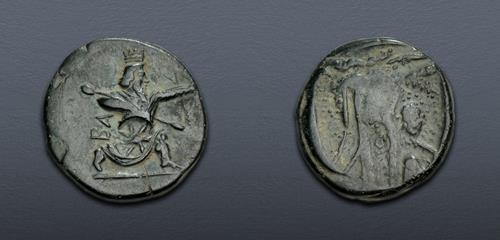
|
PERSIA, Achaemenid Empire. temp. Artaxerxes III to Darios III. Circa 350-333 BC. Æ Unit (14mm, 2.19 g). Uncertain mint in western Asia Minor (Ionia or Sardes?). VF.Electronic Auction 590 Greek, Bronze Estimate: $ 100 |
|
PERSIA, Achaemenid Empire. temp. Artaxerxes III to Darios III. Circa 350-333 BC. Æ Unit (14mm, 2.19 g). Uncertain mint in western Asia Minor (Ionia or Sardes?). Persian king, wearing kidaris and kandys, in kneeling-running stance right, holding spear in right hand, bow in left; BA to left; c/m: star within incuse circle / Incuse rectangle, containing pattern possibly depicting relief map of the hinterland of Ephesos. Johnston, Earliest, Æ 1–4; cf. Meadows, Administration 328 (tetradrachm); Mildenberg, Münzwesen pp. 25–6 and pl. XIII, 112; BMC Ionia p. 324, 7. Earthen dark green patina, flan crack, a few minor flan flaws. VF. |
|